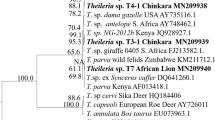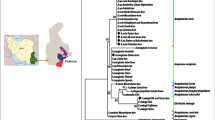Abstract
Protozoan parasites of the genus Babesia and Theileria are significant tick-borne pathogens of domestic animals and cause economic losses to the livestock industry in tropical and subtropical regions worldwide. In this study, 274 blood samples and 32 tick samples were collected from four counties of Wuwei City in northwestern China in June and July in 2018. The DNA from the field samples was analyzed for Babesia or Theileria infection using specific PCR and sequencing based on 18S rRNA gene fragments. The total infection rates were 0.4% for B. motasi and T. separata (both 1/274) in sheep, 3.1% for T. annulata (1/32), 6.2% for B. occultans (2/32) and 9.4% for B. bigemina (3/32) in ticks, respectively. In particular, T. separata has been for the first time detected in sheep in China and B. occultans in Hyalomma asiaticum from Gansu Province of China.

Similar content being viewed by others
References
Ahmed JS, Luo J, Schnittger L, Seitzer U, Jongejan F, Yin H (2006) Phylogenetic position of small-ruminant infecting piroplasms. Ann N Y Acad Sci 1081:498–504
Aktas M, Vatansever Z, Ozubek S (2014) Molecular evidence for trans-stadial and transovarial transmission of Babesia occultans in Hyalomma marginatum and Rhipicephalus turanicus in Turkey. Vet Parasitol 204:369–371
Dipeolu OO, Amoo A (1984) The presence of kinetes of a Babesia species in the haemolymph smears of engorged Hyalomma ticks in Nigeria. Vet Parasitol 17:41–46
Gray JS, De Vos AJ (1981) Studies on a bovine Babesia transmitted by Hyalomma marginatum rufipes Koch, 1844. Onderstepoort J Vet Res 48:215–223
Guan G, Chauvin A, Luo J, Inoue N, Moreau E, Liu Z, Gao J, Thekisoe OM, Ma M, Liu A, Dang Z, Liu J, Ren Q, Jin Y, Sugimoto C, Yin H (2008) The development and evaluation of a loop-mediated isothermal amplification (LAMP) method for detection of Babesia spp. infective to sheep and goats in China. Exp Parasitol 120:39–44
Kim CM, Blanco LB, Alhassan A, Iseki H, Yokoyama N, Xuan X, Igarashi I (2008) Development of a rapid immunochromatographic test for simultaneous serodiagnosis of bovine babesioses caused by Babesia bovis and Babesia bigemina. Am J Trop Med Hyg 78:117–121
Liu AH, Yin H, Guan GQ, Schnittger L, Liu ZJ, Ma ML, Dang ZS, Liu JL, Ren QY, Bai Q, Ahmed JS, Luo JX (2007) At least two genetically distinct large Babesia species infective to sheep and goats in China. Vet Parasitol 147:246–251
Liu J, Guan G, Li Y, Liu A, Luo J, Yin H (2017) A molecular survey of Babesia species and detection of a new Babesia species by DNA related to B. venatorum from white yaks in Tianzhu, China. Front Microbiol 8:419
Lu WS, Wei BY, Huang SY, Bai Q (1980) Transmission and morphological studies on Theileria annulata in Ningxia. Ningxia People’s Press, Yinchuan, pp 26–33 (in Chinese)
Luo J, Yin H (1997) Theileriosis of sheep and goats in China. Trop Anim Health Prod 29(Suppl 4):8S. https://doi.org/10.1007/BF02632907
Luo JX, Yin H, Guan GQ, Ma ML, Sun CQ, Lu BY, Bai Q, Lv WS, Chen PY (2005) Experiments on Transmission of Babesia U sp. and Theileria annulata with Hyalomma anatolicum anatolicum. Acta Veterinaria et Zootechnica Sinica 36:1191–1201
Niu Q, Yang J, Liu Z, Gao S, Pan Y, Guan G, Chu Y, Liu G, Luo J, Yin H (2017) First molecular detection of piroplasm infection in pet dogs from Gansu, China. Front Microbiol 8:1029
Robinson PM (1982) Theileriosis annulata and its transmission—a review. Trop Anim Health Prod 14:3–12
Sang R, Onyango C, Gachoya J, Mabinda E, Konongoi S, Ofula V, Dunster L, Okoth F, Coldren R, Tesh R, da Rosa AT, Finkbeiner S, Wang D, Crabtree M, Miller B (2006) Tickborne arbovirus surveillance in market livestock, Nairobi, Kenya. Emerg Infect Dis 12:1074–1080
Song R, Wang Q, Guo F, Liu X, Song S, Chen C, Tu C, Wureli H, Wang Y (2018) Detection of Babesia spp., Theileria spp. and Anaplasma ovis in border regions, northwestern China. Transbound Emerg Dis. https://doi.org/10.1111/tbed.1289433
Sun M (2016) First discovery of Argas persicus and Ornithodorus lahorensis in Minqin County of Gansu Province. China Anim Health Insp 33:1–3 (in Chinese)
Uilenberg G, Andreasen MP (1974) Haematoxenus separatus sp. n. (sporozoa, Theileriidae) of sheep in Tanzania. Rev Elev Med Vet Pays Trop 27:459–465. https://doi.org/10.19182/remvt.7942
Uilenberg G, Schreuder BE (1976) Further studies on Haematoxenus separatus (Sporozoa, Theileriidae) of sheep in Tanzania. Rev Elev Med Vet Pays Trop 29:119–126
Yang FG, Feng ZG, Yu GH, Liu JX, Wei ZQ, He XZ (1958) A report on ovie theileriosis in Ganning Animal Farm Station in Ganzi District. Chin Vet Sci 33–37 (in Chinese)
Yang JF, Li YQ, Liu ZJ, Liu JL, Guan GQ, Chen Z, Luo JX, Wang XL, Yin H (2014) Molecular evidence for piroplasms in wild Reeves’ muntjac (Muntiacus reevesi) in China. Parasitol Int 63:713–716
Yin H, Lu W, Luo J (1997) Babesiosis in China. Trop Anim Health Prod 29(Suppl 4):11S. https://doi.org/10.1007/BF02632908
Yin H, Luo J, Guan G, Gao Y, Lu B, Zhang Q, Ma M, Lu W, Lu C, Yuan Z, Guo S, Wang B, Du H, Schnittger L, Ahmed J, Jongejan F (2002) Transmission of an unidentified Theileria species to small ruminants by Haemaphysalis qinghaiensis ticks collected in the field. Parasitol Res 88(Suppl 1):S25. https://doi.org/10.1007/s00436-001-0565-4
Young AS, Mchinja SF (1977) Observations on Haematoxenus separatus Uilenberg & Andreasen 1974 in the erythrocytes of Kenyan sheep. Res Vet Sci 23:387–388
Zhou M, Cao S, Sevinc F, Sevinc M, Ceylan O, Ekici S, Jirapattharasate C, Moumouni PF, Liu M, Wang G, Iguchi A, Vudriko P, Suzuki H, Xuan X (2017) Molecular detection and genetic characterization of Babesia, Theileria and Anaplasma amongst apparently healthy sheep and goats in the central region of Turkey. Ticks Tick Borne Dis 8:246–252
Funding
This study was financially supported by the National Key Research and Development Program of China (2017YFD0501200), ASTIP (CAAS-ASTIP-2016-LVRI), Jiangsu Co-innovation Center Programme for Prevention and Control of Important Animal Infectious Disease and Zoonose.
Author information
Authors and Affiliations
Contributions
Designed the study: Jianxun Luo, Hong Yin, Guanquan Guan, and Ming Sun, performed the experiments: Ming Sun, Jinming Wang, Junlong Liu, and Jianlin Xu, analyzed the data: Zhijie Liu and Youquan Li, wrote the paper: Ming Sun, Jinming Wang, Zhijie Liu, Junlong Liu, Youquan Li, Jianlin Xu, Guanquan Guan, Hong Yin, and Jianxun Luo supervised all work. All authors have read and approve the final version of the manuscript.
Corresponding authors
Ethics declarations
Conflict of interest
The authors declare that they have no competing interests.
Ethical approval
The collection and manipulation of blood samples were approved by the Animal Ethics Committee of the Lanzhou Veterinary Research Institute, Chinese Academy of Agricultural Sciences. All sampling procedures were handled in accordance with the Animal Ethics Procedures and Guidelines of the People’s Republic of China.
Additional information
Publisher's Note
Springer Nature remains neutral with regard to jurisdictional claims in published maps and institutional affiliations.
Rights and permissions
About this article
Cite this article
Sun, M., Wang, J., Liu, Z. et al. First molecular evidence of Babesia occultans and Theileria separata infection in ticks and sheep in China. Exp Appl Acarol 78, 223–229 (2019). https://doi.org/10.1007/s10493-019-00369-1
Received:
Accepted:
Published:
Issue Date:
DOI: https://doi.org/10.1007/s10493-019-00369-1




